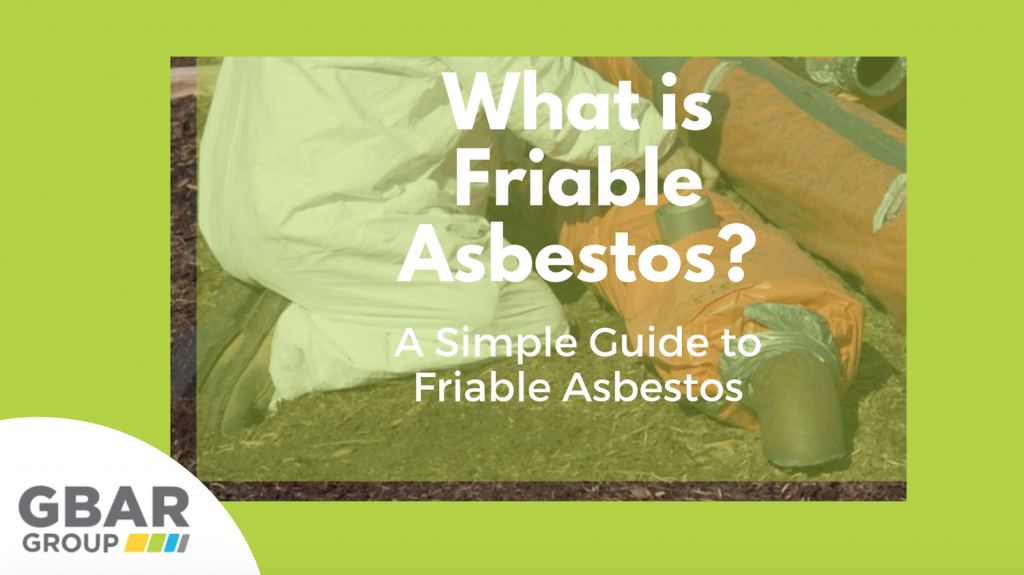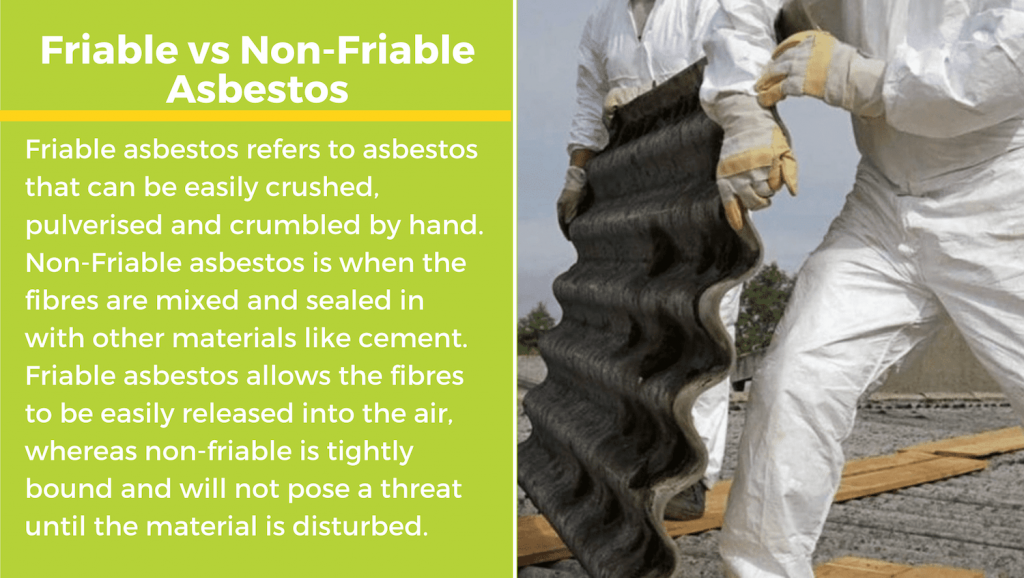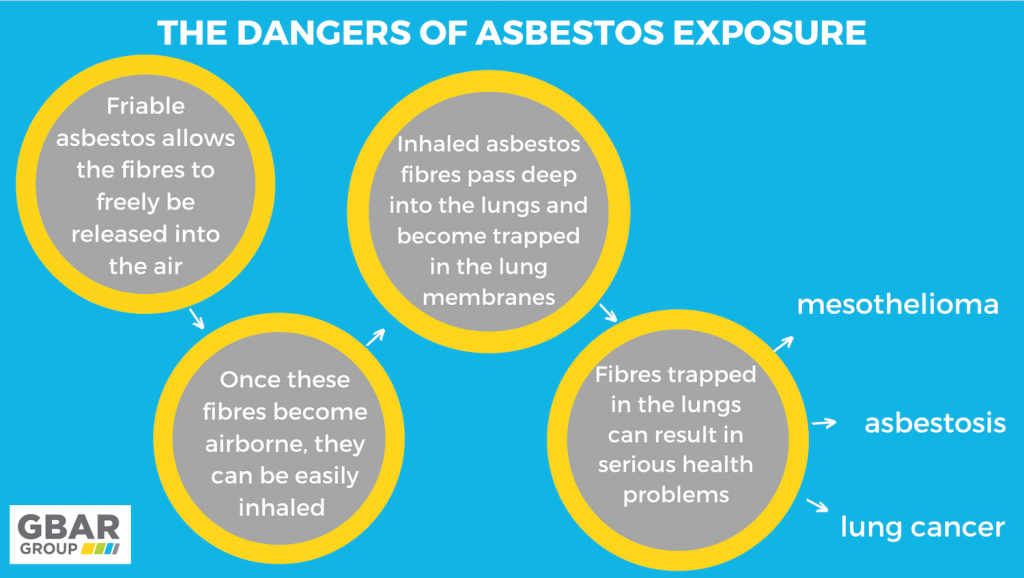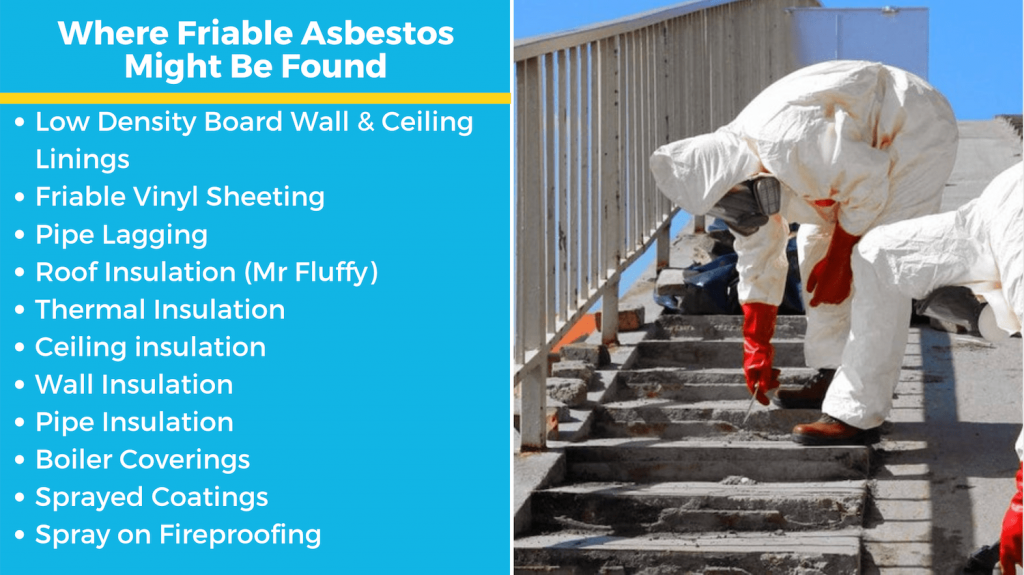
Friable asbestos is the most harmful and dangerous form of asbestos. Asbestos materials that are deemed friable are more likely to release measurable levels of asbestos into the airborne environment when disturbed, and generally, pose a greater risk to health than non-friable asbestos materials.
Asbestos is a naturally occurring fibrous silicate mineral found in rock formations. Mined and heavily used in Australia for a number of years, the three different types commonly found asbestos materials are chrysotile, amosite and crocidolite. Asbestos materials are characterised by two different forms; friable and non-friable.
Asbestos minerals are made up of bundles composed of long, thin, wiry fibres that can easily be separated from another. Well-known industrially for its strength, heat resistance and insulation properties, asbestos was widely used by the construction and manufacturing industries in Australia in the second half of the 20th Century up until It was outlawed in 2003. Asbestos fibres can be used individually for insulation or mixed in with other materials to improve the overall strength and durability of the product.
Friable asbestos refers to any asbestos-containing materials that are easily powdered or broken by hand. The word “friable” derives from the Latin word meaning “to crumble”, and friable materials are simply just that – materials that are easily crumbled. Often quite dry, loose, and fibrous, friable asbestos can be determined by the ability to crush or pulverise the material with light pressure.

Why is Friable Asbestos So Dangerous?
During the peak period of asbestos consumption, Australia was one of the highest users of asbestos per capita. Prior to the increased awareness of the dangers of asbestos, it was heavily used on residential, commercial, and industrial sites. The properties of asbestos fibres meant that asbestos provided great strength, durability, heat resistance, chemical resistant and did not conduct electricity. It was considered an excellent building and manufacturing material that was versatile, affordable and increasingly accessible.
Asbestos is most hazardous when it is raw, loose and friable. Materials are classed as friable when they can be easily crushed or crumbled by hand, releasing the fibres into the air. Once asbestos fibres are turned to dust and released into the air, they become airborne and are extremely dangerous.
Airborne asbestos fibres look like tiny dust particles and are practically invisible to the naked eye. Easily ingested and inhaled, the most common way for asbestos exposure to occur is through breathing them in. Many of the fibres will become trapped in the mucous membranes of the nose and throat where they can be removed. However, some are likely to pass deep into the lungs, or, if swallowed, into the digestive tract. Once asbestos fibres enter these parts of the body, the fibres become permanently trapped and can cause serious health problems.

Asbestos-Related Illnesses
Asbestos exposure is directly linked to the development of a number of asbestos-related illnesses. Once asbestos fibres enter the lung membranes, they become trapped and cause irreversible lung damage. The most common and significant asbestos-related illnesses include:
1. Asbestosis
Asbestosis is a chronic, non-cancerous respiratory condition. When someone is exposed to raw asbestos, the fibres aggravate the lung tissues, causing them to scar. This scarring is referred to asbestosis. Asbestosis is long-term and often will develop years after the initial exposure. Symptoms of asbestosis include shortness of breath, coughing, wheezing and chest tightness. Asbestosis complications may develop into lung cancer, mesothelioma, and pulmonary heart disease.
2. Mesothelioma
Mesothelioma is a rare, aggressive form of cancer that occurs in the thin membrane lining of vital organs. Commonly found in the tissue lining of the lungs, chest, abdomen and heart, mesothelioma is directly caused by asbestos exposure. Once the cancer cells have spread beyond the original location, the mesothelioma is considered advanced and surgery is no longer an option. Depending on duration and amount of asbestos exposure, the average length of latency for malignant mesothelioma is 35 to 40 years between exposure and diagnosis.
3. Lung Cancer
Lung Cancer contributes to the largest number of deaths associated with asbestos exposure. The incidence of lung cancer in people who are directly involved in the mining, milling, manufacturing and use of asbestos and its products is much higher than the rest of the general population. Asbestos fibres enter the lungs, scar the lung membranes, eventually attack the lung tissue, and develop into lung cancer cells. There is a much higher risk of developing lung cancer from asbestos exposure if the person is also a smoker. Symptoms of asbestos lung cancer include shortness of breath and chest pain
What is Asbestos Friability?
Friability is the tendency for asbestos-containing materials to break down, chip or crumble under pressure or as a result of abrasion. Asbestos Friability occurs when non-friable asbestos-containing product is damaged or disturbed. Once the tight bond that contains the asbestos fibres within the product breaks, the material transitions from non-friable to friable, and becomes harmful.
The risk of asbestos and asbestos exposure is determined by its friability levels. All asbestos fibres are harmful, however, if the fibres are tightly wound, bound within the cement, or sealed, they do not pose a human threat until the materials become friable.
As these products weather, age, and become damaged, even minimal contact such as brushing against them can cause crumbling and fibre release. If these tiny fibres become airborne and are breathed in, the potential for inhalation and subsequentially, asbestos-related illness, is very high.
Asbestos Friability can also occur when someone purposely cuts, breaks, smashes, sands or saws non-friable asbestos materials. As soon as the material or product is disturbed, the asbestos-containing material can be classed as friable as the particles are released from the product.
Examples of Friable Asbestos

- Low-density Board Wall & Ceiling Linings
- Friable Vinyl Sheeting
- Pipe Lagging
- Roof Insulation (Mr Fluffy)
- Thermal Insulation
- Ceiling insulation
- Wall Insulation
- Pipe Insulation
- Boiler Coverings
- Sprayed Coatings
- Spray on Fireproofing
How Do I Know If the Asbestos Is Friable?
Friable asbestos can be identified by the condition of the asbestos-containing material. If the material is loose, can be easily crushed or powdered and is crumbly, it is definitely friable. Non-friable asbestos will be tightly bound, sealed and locked into a material that has not been disturbed or damaged in any way.
The most certain way to correctly identify friable asbestos is to have it properly sampled and tested by an accredited asbestos specialist. A sample of the material will safely be taken and sent off to a lab to make the assessments.
Once the friable asbestos has been positively identified, it will need to be immediately handled and removed by a licensed asbestos abatement team to avoid further contamination. Here at GBAR Group, our asbestos specialists are licensed Australia-wide and specialise in the removal, disposal and remediation of friable asbestos-contaminated sites.
Handling Friable Asbestos
Friable asbestos is incredibly dangerous to human health, and these materials are likely to release measurable levels of harmful asbestos fibre into the airborne environment. It is not safe nor legal for a homeowner to handle or remove friable asbestos without the appropriate licensing, training and asbestos accreditations in Australia.
The health risks associated with friable asbestos exposure are impossible to overstate. If you suspect your home or property contains friable asbestos materials, have an asbestos specialist safely assess, remove, and dispose of the materials. GBAR Group is Australia’s most trusted Asbestos removal and hazardous waste remediation group. Our specialist operatives are rigorously trained in correct and safe asbestos removal to ensure the attendant risks are minimised as far as possible.
The team at GBAR will assess your site, assist in the identification, measuring and quantifying of the risk, provide advice and a request quote on removal options undertaken in conjunction with occupational hygienists. If you wish to proceed, we remove the asbestos, dispose of the harmful materials, and remediate the site. Our Sydney and Brisbane GBAR teams are committed to safety and providing the highest quality asbestos removal and remediation in Australia.






